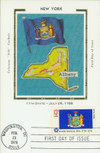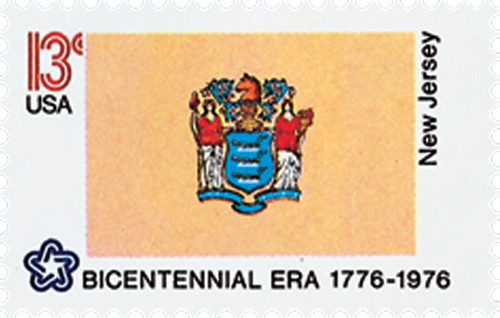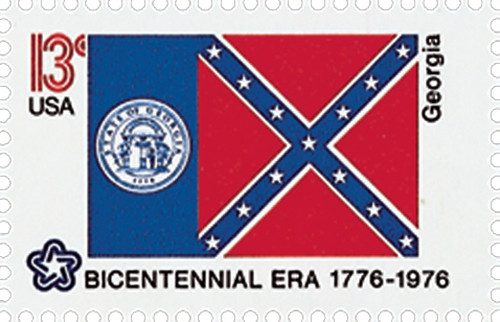
# 1643 - 1976 13c State Flags: New York
U.S. 1643
1976 New York Flag
State Flags
American Bicentennial Series
• First time a sheet 50 had all different stamp designs
• Part of the American Bicentennial Series
Stamp Category: Commemorative
Series: American Bicentennial Series
Value: 13¢ First-class postage rate
First Day of Issue: February 23, 1976
First Day City(s): Washington, DC
Quantity Issued: 8,720,100 (panes of 50)
Printed by: Bureau of Engraving and Printing
Printing Method: Photogravure
Format: Sheet of 50
Perforations: 11
Why the stamp was issued:
The United States Postal Service celebrated the American Bicentennial with a full pane of the Union’s fifty state flags.
About the stamp design:
The New York State emblem in the center of the state flag. Between supporters Liberty and Justice a shield shows a ship and sloop on a river bordered by a grassy shore and a mountain range with the sun rising behind it. Above it is the earth with an eagle perched on top with outstretched wings. Below the shield are the words Excelsior and E Pluribus Unum which means “Ever Upward” and “Out of many one.”
About the printing process: Printed by the Bureau of Engraving and Printing on their seven-color Andreotti gravure press (601) which was their work horse for multicolored stamps.
About the American Bicentennial Series:
In the 1970s, America celebrated its 200th anniversary with hundreds of national events commemorating the heroes and historic events that led to our nation’s independence from Great Britain. The U.S. Postal Service issued 113 commemorative stamps over a six-year period in honor of the U.S. bicentennial, beginning with the American Revolution Bicentennial Commission Emblem stamp (U.S. #1432). As a group, the Bicentennial Series chronicles one of our nation’s most important chapters, and remembers the events and patriots who made the U.S. a world model for liberty.
Several of the stamps honored colonial life – craftsmen and communication. Other stamps honored important battles including Lexington and Concord, Bunker Hill, and Saratoga. Significant events such as the Boston Tea Party, the meeting of the First Continental Congress, and the Declaration of Independence were featured as well. The stamps also honored many significant people such as George Washington, Sybil Ludington, Salem Poor, and the Marquis de Lafayette.
Many of the stamps feature classic artwork. For instance, the set of four souvenir sheets picture important events recreated by noted artists such as John Trumbull. The Bicentennial Series also includes an important US postal first – the first 50-stamp se-tenant – featuring all 50 state flags. The format proved to be popular with collectors, and has been repeated many times since.
The American Bicentennial Series is packed with important US history – it tells the story of our nation’s fight for independence through stamps.
History the stamp represents:
On July 26, 1788, New York ratified the U.S. Constitution, becoming America’s 11th state.
Two of the most powerful Indian groups in North America lived in New York, the Algonquian family and the Iroquois. These tribes were large and well organized, especially the Iroquois. The Iroquois federation was the most efficient North American Indian government.
Giovanni da Verrazzano, an Italian explorer sailing for France, was probably the first European to reach New York in 1524. Henry Hudson, an Englishman serving the Dutch, sailed up the Hudson River in 1609. His exploration gave the Netherlands rights to the territory of much of New York, New Jersey, Delaware, and part of Connecticut. The Dutch called this land New Netherland. In 1609, the French explorer Samuel de Champlain entered the northern portion of New York, claiming that area for his country.
In 1621, a group of Dutch merchants formed the Dutch West India Company, and were given exclusive rights to trade in New Netherland for 24 years. The company sent 30 families to settle the region in 1624. Some of these people founded Fort Orange, now known as Albany. This was the first permanent European settlement in New York. In 1625, a group of Dutch colonists began building a fort and town, called New Amsterdam, on Manhattan Island. The next year, the Dutch governor, Peter Minuit, bought Manhattan from the Indians for goods worth 60 Dutch guilders – about $24.
Over time, the English became more interested in the area, and in 1664, King Charles II of England granted his brother, James, the Duke of York, a charter for the New Netherland area. A fleet of English warships was sent to take the area. When the ships arrived in today’s New York harbor, New Amsterdam’s governor, Peter Stuyvesant, surrendered without a fight. The English renamed the area New York, after the Duke of York. The Duke would later become King James II of England.
While the English took control of southern New York, the French moved into the north. The French built a fort at Crown Point on Lake Champlain in 1731. War had broken out in Europe between France and England in 1689. Soon, New York became a battlefield. From 1689 to 1763, the French and their Algonquian allies, as well as the English and their Iroquois allies, fought a series of four wars. These costly conflicts delayed new exploration and settlement in New York. A peace pact was signed on February 10, 1763. The wars cost France all of her possessions in North America.
Many New Yorkers resented the presence of British soldiers, authoritative royal judges, and taxation without representation. Still, some citizens remained loyal to the crown during the American Revolution. Additionally, these Loyalists aided the British and enlisted the help of the Iroquois as allies against the patriots.
New York established its first independent government in 1776. On February 6, 1778, New York approved the Articles of Confederation. Although New York was opposed to a strong federal government, it ratified the United States Constitution on July 26, 1788.
Following the Civil War, New York has largely benefitted from economic growth. It is the nation’s leading center of banking, communications, and finance. New York City is the largest city in the U.S. and the 6th largest in the world. It is one of the world’s leading business centers, and has one of the world’s biggest and busiest seaports. The United Nations headquarters are based there as well, leading many people to claim New York City as the “capital of the world.”
U.S. 1643
1976 New York Flag
State Flags
American Bicentennial Series
• First time a sheet 50 had all different stamp designs
• Part of the American Bicentennial Series
Stamp Category: Commemorative
Series: American Bicentennial Series
Value: 13¢ First-class postage rate
First Day of Issue: February 23, 1976
First Day City(s): Washington, DC
Quantity Issued: 8,720,100 (panes of 50)
Printed by: Bureau of Engraving and Printing
Printing Method: Photogravure
Format: Sheet of 50
Perforations: 11
Why the stamp was issued:
The United States Postal Service celebrated the American Bicentennial with a full pane of the Union’s fifty state flags.
About the stamp design:
The New York State emblem in the center of the state flag. Between supporters Liberty and Justice a shield shows a ship and sloop on a river bordered by a grassy shore and a mountain range with the sun rising behind it. Above it is the earth with an eagle perched on top with outstretched wings. Below the shield are the words Excelsior and E Pluribus Unum which means “Ever Upward” and “Out of many one.”
About the printing process: Printed by the Bureau of Engraving and Printing on their seven-color Andreotti gravure press (601) which was their work horse for multicolored stamps.
About the American Bicentennial Series:
In the 1970s, America celebrated its 200th anniversary with hundreds of national events commemorating the heroes and historic events that led to our nation’s independence from Great Britain. The U.S. Postal Service issued 113 commemorative stamps over a six-year period in honor of the U.S. bicentennial, beginning with the American Revolution Bicentennial Commission Emblem stamp (U.S. #1432). As a group, the Bicentennial Series chronicles one of our nation’s most important chapters, and remembers the events and patriots who made the U.S. a world model for liberty.
Several of the stamps honored colonial life – craftsmen and communication. Other stamps honored important battles including Lexington and Concord, Bunker Hill, and Saratoga. Significant events such as the Boston Tea Party, the meeting of the First Continental Congress, and the Declaration of Independence were featured as well. The stamps also honored many significant people such as George Washington, Sybil Ludington, Salem Poor, and the Marquis de Lafayette.
Many of the stamps feature classic artwork. For instance, the set of four souvenir sheets picture important events recreated by noted artists such as John Trumbull. The Bicentennial Series also includes an important US postal first – the first 50-stamp se-tenant – featuring all 50 state flags. The format proved to be popular with collectors, and has been repeated many times since.
The American Bicentennial Series is packed with important US history – it tells the story of our nation’s fight for independence through stamps.
History the stamp represents:
On July 26, 1788, New York ratified the U.S. Constitution, becoming America’s 11th state.
Two of the most powerful Indian groups in North America lived in New York, the Algonquian family and the Iroquois. These tribes were large and well organized, especially the Iroquois. The Iroquois federation was the most efficient North American Indian government.
Giovanni da Verrazzano, an Italian explorer sailing for France, was probably the first European to reach New York in 1524. Henry Hudson, an Englishman serving the Dutch, sailed up the Hudson River in 1609. His exploration gave the Netherlands rights to the territory of much of New York, New Jersey, Delaware, and part of Connecticut. The Dutch called this land New Netherland. In 1609, the French explorer Samuel de Champlain entered the northern portion of New York, claiming that area for his country.
In 1621, a group of Dutch merchants formed the Dutch West India Company, and were given exclusive rights to trade in New Netherland for 24 years. The company sent 30 families to settle the region in 1624. Some of these people founded Fort Orange, now known as Albany. This was the first permanent European settlement in New York. In 1625, a group of Dutch colonists began building a fort and town, called New Amsterdam, on Manhattan Island. The next year, the Dutch governor, Peter Minuit, bought Manhattan from the Indians for goods worth 60 Dutch guilders – about $24.
Over time, the English became more interested in the area, and in 1664, King Charles II of England granted his brother, James, the Duke of York, a charter for the New Netherland area. A fleet of English warships was sent to take the area. When the ships arrived in today’s New York harbor, New Amsterdam’s governor, Peter Stuyvesant, surrendered without a fight. The English renamed the area New York, after the Duke of York. The Duke would later become King James II of England.
While the English took control of southern New York, the French moved into the north. The French built a fort at Crown Point on Lake Champlain in 1731. War had broken out in Europe between France and England in 1689. Soon, New York became a battlefield. From 1689 to 1763, the French and their Algonquian allies, as well as the English and their Iroquois allies, fought a series of four wars. These costly conflicts delayed new exploration and settlement in New York. A peace pact was signed on February 10, 1763. The wars cost France all of her possessions in North America.
Many New Yorkers resented the presence of British soldiers, authoritative royal judges, and taxation without representation. Still, some citizens remained loyal to the crown during the American Revolution. Additionally, these Loyalists aided the British and enlisted the help of the Iroquois as allies against the patriots.
New York established its first independent government in 1776. On February 6, 1778, New York approved the Articles of Confederation. Although New York was opposed to a strong federal government, it ratified the United States Constitution on July 26, 1788.
Following the Civil War, New York has largely benefitted from economic growth. It is the nation’s leading center of banking, communications, and finance. New York City is the largest city in the U.S. and the 6th largest in the world. It is one of the world’s leading business centers, and has one of the world’s biggest and busiest seaports. The United Nations headquarters are based there as well, leading many people to claim New York City as the “capital of the world.”


















